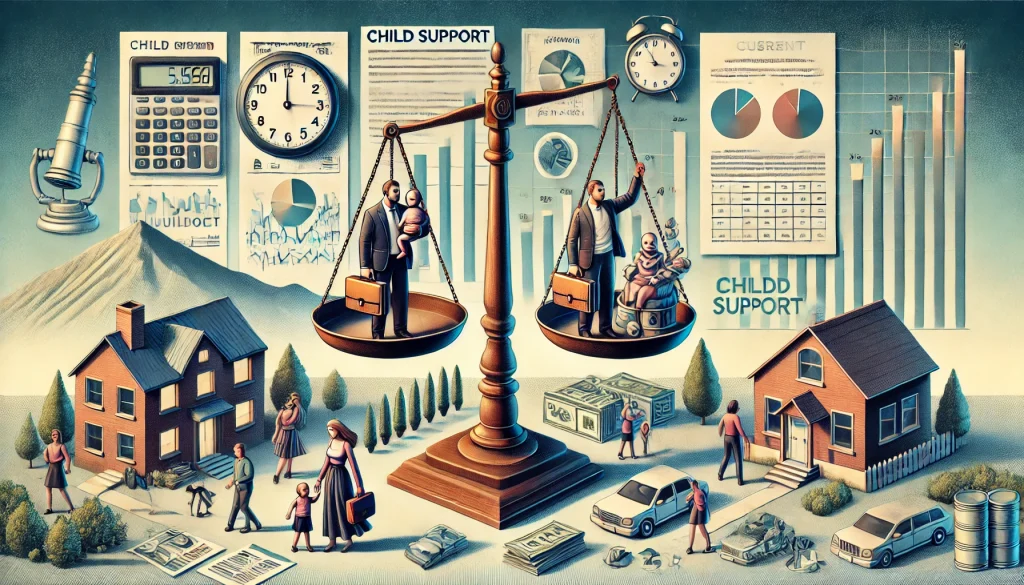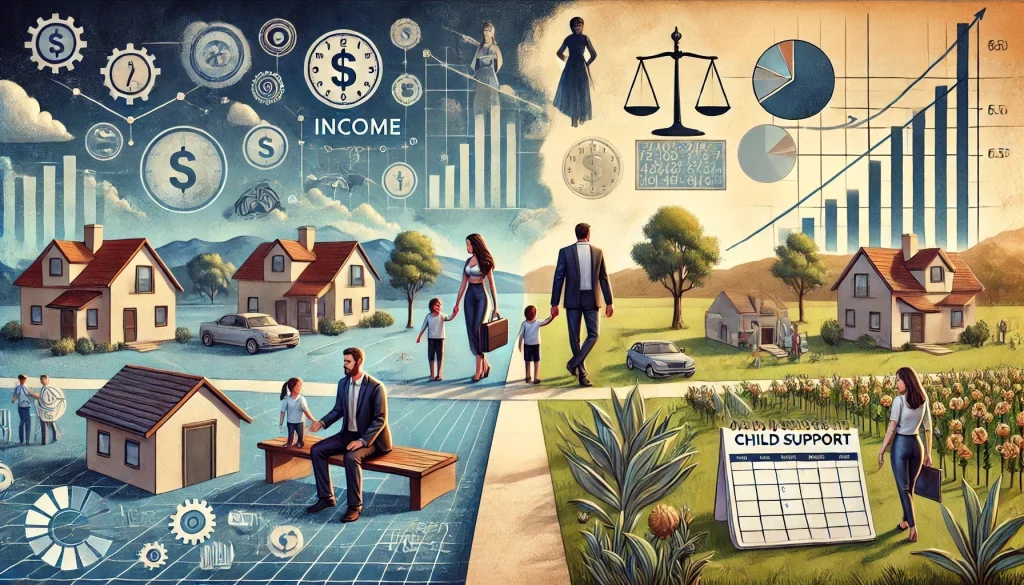Did you know that over 53% of households in the U.S. are dual income (BLS) (MagnifyMoney)? Despite this significant shift in family dynamics, child support laws remain stuck in the past, often leaving one parent disproportionately burdened. When my ex-wife and I divorced, I assumed our financial responsibilities for our son would be equally shared, especially since we both worked full-time. But the reality was far different. Despite sharing 50-50 custody, I found myself paying a significant portion of my income in child support. This isn’t just my story—it’s a widespread issue affecting countless modern families.
The child support system, designed decades ago when single-income households were the norm, now unfairly penalizes parents in dual-income households, especially those with shared custody arrangements. For instance, when these laws were created, the assumption was that fathers were the primary breadwinners, and mothers were typically homemakers without their own income. Today, women’s financial contributions have increased significantly, with 55% of marriages now featuring husbands as the primary or sole contributors to the couple’s earnings (Pew Research Center).
However, the legal framework has not caught up with these changes, resulting in outdated and unfair practices.
Imagine having to pay 25% – 40% of your income in child support depending on how many children you have, even though you and your ex-spouse share custody equally and both earn similar incomes. This is the reality for many modern families, and it’s causing undue financial strain. The current child support system is riddled with biases that unfairly burden fathers, even when both parents share custody equally. It’s time to address these disparities and push for a more equitable approach.
As family dynamics evolve, so too must our legal frameworks. This post explores why dual-income households and 50-50 custody arrangements deserve fairer treatment and proposes necessary reforms to modernize child support laws to reflect today’s economic and familial realities.
Historical Context of Child Support Laws

Child support laws were established during a time when the socio-economic landscape was vastly different from what it is today. In the mid-20th century, the typical family structure featured a single-income household where the father was the primary breadwinner and the mother managed the home and children. This period saw the creation of child support laws designed to ensure that children did not suffer financially after a divorce, as mothers typically had little to no income of their own.
The federal government began intervening in child support enforcement with legislation in the 1950s and 1960s. By 1975, the Child Support Enforcement (CSE) program was enacted as a federal-state program under Title IV-D of the Social Security Act. The primary goal was to reduce public expenditures on welfare by ensuring noncustodial parents contributed to the financial support of their children. This program aimed to reimburse states and the federal government for welfare payments provided to families and to help non-welfare families remain self-sufficient and off public assistance (EveryCRSReport).
During the 1950s to 1970s, these laws were crucial in providing financial security for children and the primary caregiver. However, as society has evolved, so too have family structures. The rise of dual-income households has been significant, with more than 53% of U.S. households now having both parents working (BLS) (MagnifyMoney). Despite this shift, child support laws have not kept pace with these changes.
Originally, child support laws aimed to prevent financial hardship for children and the primary caregiver post-divorce. They were based on the assumption that one parent (usually the mother) would not have a significant income and would need financial support to raise the children. While this made sense in an era dominated by single-income households, it does not reflect the reality of modern families.
Today’s families often feature both parents working full-time jobs and sharing custody of their children. However, the legal framework surrounding child support has remained largely unchanged. This lack of adaptation means that many fathers, despite having 50-50 custody and equal financial responsibilities, are still required to pay substantial amounts of child support. This outdated approach unfairly burdens one parent, typically the father, and does not account for the shared financial responsibilities that characterize modern parenting.
To truly understand why child support laws need to be reformed, we must first recognize their outdated foundations. By acknowledging the historical context in which these laws were created, we can better appreciate the urgent need to update them to reflect today’s dual-income and equal custody arrangements.
Modern Family Dynamics
In recent decades, the structure of American families has undergone significant changes. One of the most notable shifts has been the rise of dual-income households. According to recent statistics, around 60% of married couples in the United States work for income (GITNUX). This represents a major departure from the mid-20th century, when single-income households were the norm and fathers were typically the primary breadwinners.
The roles of mothers and fathers have evolved substantially over the years. Today, more mothers are participating in the workforce, and many families share parenting responsibilities more equally. This shift has led to a rise in 50-50 custody arrangements, where both parents spend equal time with their children and contribute financially to their upbringing.
Despite these changes, the child support system has not kept pace. Current laws, which were designed for an era of single-income households, fail to account for the realities of modern families. As a result, many fathers who share custody equally and earn similar incomes to their ex-spouses find themselves disproportionately burdened by child support payments.
These financial challenges are significant. Fathers must maintain separate households, often facing higher costs due to the loss of dual-income benefits. Additionally, they may lose tax breaks and face increased expenses for things like insurance and daily living costs. These factors can place a substantial financial strain on fathers, even when they are equally responsible for their children’s upbringing.
Dual-income households provide numerous benefits for children, including better financial stability and shared parental involvement. However, the current child support system undermines these benefits by disproportionately penalizing one parent. To address this, we need to reform child support laws to reflect modern family dynamics.
One proposed reform is to recalculate child support based on actual custody time and both parents’ incomes, rather than just income disparity. This would ensure a fairer distribution of financial responsibilities and support the dual-income model that benefits so many families today.
The Flaws in Current Child Support Calculations

The current system for calculating child support primarily relies on the income disparity between parents, often without adequately considering the actual time each parent spends with the child. This method, rooted in outdated assumptions about family roles, results in significant financial burdens, particularly for fathers who share 50-50 custody.
Basis of Current Calculations: Child support calculations in the U.S. typically follow one of two main models: the income shares model and the percentage of income model. In the income shares model, used by the majority of states, both parents’ incomes are combined, and child support is allocated based on the proportion of each parent’s income and the amount of time they spend with the child. However, the primary consideration remains the income disparity (Custody Schedules and Parenting Plans) (usacalculators.com).
Income Disparity and Bias: Under the existing framework, child support payments are determined by comparing the incomes of both parents. The parent with the higher income is typically required to pay support to the other parent, regardless of how equally custody is shared. This approach fails to recognize the financial contributions both parents make and the substantial costs involved in maintaining separate households post-divorce. For example, even in states using the income shares model, the calculations often do not fully account for the actual time spent with the child, leading to disproportionate financial burdens on the higher-earning parent (usacalculators.com) (NH Health & Human Services).
Real-Life Examples: Many fathers who share equal custody find themselves paying substantial amounts of child support despite contributing equally to their child’s upbringing. In one case, a father with 50-50 custody and a similar income to his ex-spouse was still required to pay 25% of his net income in child support. This financial strain is compounded by the loss of dual-income benefits, increased costs for insurance, and the need to maintain separate households. These challenges illustrate the flaws in the current system and the need for reform.
Financial Strain on Fathers: The financial challenges fathers face under the current system are significant. They often have to manage higher expenses while losing critical tax breaks available to dual-income households. This can lead to a reduced quality of life for both the father and the child, as financial stress impacts overall well-being and the ability to provide for the child’s needs. Additionally, fathers are often required to pay for expenses such as housing, utilities, and transportation in two separate households, further increasing their financial burden.
Impact on Children’s Well-Being: The financial strain on fathers can indirectly affect children by reducing the resources available for their upbringing. This could mean fewer opportunities for extracurricular activities, educational resources, or even basic needs. Ensuring that both parents have the financial capacity to support their children equally is crucial for the child’s overall well-being.
Proposing a Fairer System

Given the significant flaws in the current child support calculation process, it’s clear that a modernized approach is needed to reflect the realities of today’s family dynamics. A fairer system would consider both parents’ incomes and actual custody time, ensuring that financial responsibilities are distributed equitably.
Basis for Reforms: The current system’s reliance on income disparity alone is outdated and fails to account for the shared parenting responsibilities that characterize many modern families. To create a fairer and more effective child support framework, we need to adopt a holistic approach that takes into account both parents’ financial contributions and the actual time they spend with their children.
Proposed Reforms: Several specific reforms could help achieve this goal:
- Recalculate Child Support Based on Parenting Time: Child support should be calculated based on the actual time each parent spends with their child. This approach would ensure that financial responsibilities are aligned with parenting duties. Currently, nine states do not use a parenting time adjustment (PTA), meaning that a parent could have equal custody but still pay the same amount as if they had no custody time (National Parents Organization).
- Consider Both Parents’ Incomes: Both parents’ incomes should be considered in the calculation, rather than focusing solely on the income disparity. This would provide a more accurate reflection of each parent’s financial capacity to support their child.
- Implement Financial Oversight Systems: To ensure that child support funds are used appropriately, systems similar to those used for public assistance programs could be implemented. This oversight would increase transparency and accountability, ensuring that the support truly benefits the child (Deloitte United States) (Women’s Congressional Policy Institute).
Benefits of a Reformed System: These reforms would create a fairer system for both parents, reducing the financial strain on higher-earning parents who share custody equally. For children, a reformed system would provide better financial stability and reduce conflicts between parents, contributing to a more positive upbringing.
Addressing Potential Challenges: Implementing these reforms may present challenges, such as resistance from those benefiting from the current system or the complexity of overhauling established processes. To address these challenges, a phased implementation or pilot programs could be introduced to test and refine the new approach. Additionally, providing support for parents during the transition period would help ensure a smooth implementation (National Parents Organization).
Examples from Other Jurisdictions: Looking at other jurisdictions that have successfully reformed their child support systems can provide valuable insights. For instance, Australia has implemented a system where child support payments are calculated based on both parents’ incomes and actual parenting time. This approach has led to fairer outcomes and reduced conflicts between parents (Verywell Family).
Gender Bias in Child Support Laws

Child support laws in the United States have long been influenced by historical gender roles, which have led to inherent biases favoring mothers as primary caregivers. These laws were created during a time when societal norms dictated that fathers were the primary breadwinners and mothers were homemakers. As a result, the legal framework often assumes that mothers need financial support from fathers to raise their children.
Evidence of Gender Bias: Studies have shown that there is a significant discrepancy in child support payments between fathers and mothers. For instance, about 90% of child custody arrangements give primary custody to the mother (Bikel Rosenthal & Schanfield). Additionally, the U.S. Census Bureau reports that 79.9% of custodial parents are women (Bikel Rosenthal & Schanfield). This disparity highlights the bias embedded in the system, where fathers are often seen as the default financial providers, regardless of the actual family dynamics.
Personal Stories and Case Studies: Many fathers have experienced the negative impact of gender bias in the child support system. For example, one father with 50-50 custody and a similar income to his ex-spouse was still required to pay a substantial portion of his income in child support. This financial burden not only strained his finances but also affected his ability to provide for his child’s needs during his custody periods.
Legal Framework and Enforcement: Current legal frameworks and enforcement mechanisms further perpetuate gender bias. Policies such as automatic wage garnishment and severe penalties for non-payment disproportionately impact fathers, often leading to financial ruin and even incarceration. These measures, while designed to ensure compliance, can be excessively punitive and fail to consider the financial realities faced by many fathers (Weinman Family Law).
Impact on Fathers and Children: The financial and emotional toll of gender bias in child support laws on fathers can be significant. Fathers may struggle to meet their financial obligations while maintaining a stable household for their children. This strain can lead to reduced quality of life for both the father and the child, as well as strained parent-child relationships. Children may indirectly suffer from the financial instability and emotional stress experienced by their fathers.
Addressing Gender Bias: To address gender bias in child support laws, several reforms can be proposed:
- Gender-Neutral Language and Policies: Updating the language of child support laws to be gender-neutral and ensuring policies do not favor one parent over the other based on gender.
- Training Programs: Implementing training programs for judges and family law practitioners to recognize and mitigate gender bias in their decisions and practices.
- Equal Financial Assessment: Ensuring that child support calculations fairly consider the financial contributions and responsibilities of both parents, without defaulting to outdated gender roles (Weinman Family Law) (Bikel Rosenthal & Schanfield).
Examples from Other Jurisdictions: Looking at other jurisdictions that have successfully addressed gender bias in their child support systems can provide valuable insights. Some states and countries have implemented reforms that promote fairness and equality, resulting in more balanced outcomes for both parents and children.
Legal Advocacy and Public Assistance Comparisons

To drive meaningful change in child support laws, it’s essential to support the efforts of advocacy groups and learn from the successes of other public assistance programs. These initiatives can provide a roadmap for creating a more equitable and transparent child support system.
Legal Advocacy for Reform: Several advocacy groups are actively working to reform child support laws to better reflect modern family dynamics. Organizations such as the National Parents Organization (NPO) and The Fathers’ Rights Movement are dedicated to promoting shared parenting and fairer child support policies. The NPO’s Child Support and Shared Parenting Report Card evaluates the effectiveness of state policies in supporting equal parenting and provides valuable insights for reform efforts (The Father’s Rights Movement) (Verywell Family).
Public Assistance Comparisons: Public assistance programs, like food stamps (SNAP), have implemented stringent financial oversight to ensure funds are used appropriately. These programs require recipients to spend their benefits on specific items, and transactions are closely monitored. Implementing similar oversight mechanisms in the child support system could ensure that funds are spent on the child’s needs, increasing transparency and accountability (NCSEA).
Importance of Financial Oversight: Transparency and accountability are crucial in ensuring that child support funds benefit the child. Proposals for financial oversight include requiring detailed spending reports from custodial parents and using electronic payment systems that track expenditures. These measures would help guarantee that child support money is used as intended, addressing concerns about misuse (NCSEA).
Successful Reform Examples: Several jurisdictions have successfully reformed their child support systems to promote fairness and transparency. For instance, Australia has implemented a system where child support payments are calculated based on both parents’ incomes and actual parenting time. This approach has led to fairer outcomes and reduced conflicts between parents (Verywell Family).
To support these necessary reforms, individuals must get involved. Contacting lawmakers, joining advocacy groups, and raising awareness about the need for change are all crucial steps. By advocating for a child support system that reflects the realities of modern family dynamics, we can ensure fairness for all parents.
Practical Steps for Involvement:
- Contact Lawmakers: Reach out to your state and federal representatives to express your support for child support reform.
- Join Advocacy Groups: Become a member of organizations like the National Parents Organization to stay informed and participate in advocacy efforts.
- Raise Awareness: Use social media and community platforms to share information about the need for child support reform and how others can get involved.
By working together, we can create a child support system that better reflects the realities of modern family dynamics and ensures fairness for all parents.
Conclusion
In conclusion, it is evident that our child support laws are in dire need of reform. These laws, rooted in outdated assumptions about family roles and dynamics, fail to account for the realities of modern dual-income households and shared parenting responsibilities. Fathers, in particular, are disproportionately burdened by a system that often overlooks their significant contributions to their children’s lives.
We have discussed the flaws in the current calculation methods, the inherent gender bias, and the critical need for transparency and accountability in the use of child support funds. By adopting a fairer system that considers both parents’ incomes and actual custody time, we can ensure a more equitable distribution of financial responsibilities.
The path to reform is not easy, but it is essential. Advocacy groups like the National Parents Organization and The Fathers’ Rights Movement are already making strides towards fairer policies. By supporting these efforts and taking action ourselves, we can help drive the change that is so desperately needed.
I urge you to contact your lawmakers, join advocacy groups, and raise awareness about the need for child support reform. Together, we can create a system that better reflects the realities of modern family dynamics and ensures fairness for all parents.
Change is possible, and it starts with each of us. By working together and advocating for justice, we can build a child support system that truly supports the best interests of our children and respects the contributions of both parents. Let’s take this opportunity to make a difference.
